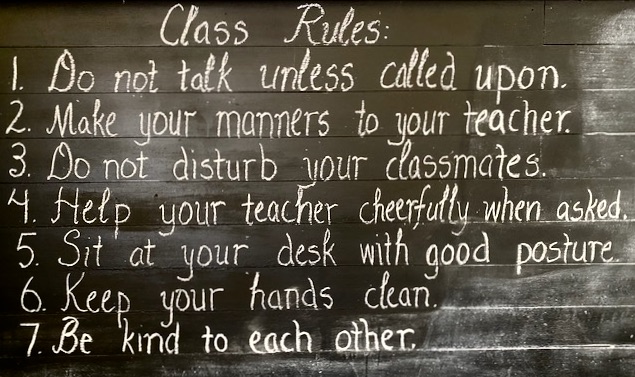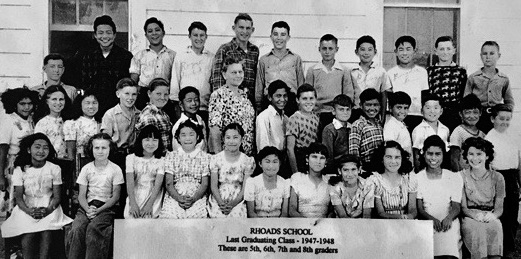The Rhoads School Living History Program
The Rhoads School Program is a living history program available to the schools of Sacramento County. In it, students are immersed in another era and participate in typical activities of that era in a historical setting. In this case, the children become students in a one-room schoolhouse operating around 1890 in a typical rural district. The students experience a typical day of children of that era, in dress, manners, chores, recreational activities, and classroom lessons. The objective is for children to develop empathy and have deeper understanding of the lives of people of that time and find an appreciation for present material advancements.
Because the program requires so much active participation by the students, including role-playing, it is important that the students are well prepared for the day. They will retain and understand more historical and cultural significance of their activities if they have some background, as well as some skills. The student will become a historical character for the day, doing morning chores, preparing for school, going to school, and participating in schoolhouse lessons. A child of that era would naturally already know some of the basic things that our children may not be familiar with for example what a privy is, how to play marbles and jacks, or how to find lessons in a McGuffy Reader.
A teaching handbook has been developed to help you prepare your students for these and other activities. Much of this will be covered during the docent pre-classroom visit to your classroom. On the day of the field trip the docent plays the role of the schoolmarm.
The school is small, with seats for about 30 students. At least four parents are needed to accompany the class, to assist with recess games, lunch, etc. These parent volunteers would benefit by being present at the pre-visit to learn their roles. All those attending the trip to the Rhoads School should dress appropriately (i.e., no shorts, etc.). Some children’s costumes and mother’s skirts are available and should be requested of the docent prior to the pre-visit.
To: Teaching Staff & Field Trip Coordinators,
We’re very proud of our pioneer school in the Elk Grove Park and want you to be aware of the Living History Program available there. Schools in the Elk Grove area have been scheduling 3rd and 4th grade class visits to the school since 1977.
We are taking reservations now. We usually have a full schedule of requests for the spring. However, our program is open from September through June. Most teachers use the field trip to cap the teaching they have done throughout the year, but it could also be used at the beginning of the school year as a building block for the rest of the year. To make a reservation, please contact Roberta Tanner by email at clantanner@aol.com or call (916) 214-8345.
We have a small number of scholarships, which will cover the cost of the program for classes who want to participate but have limited resources. Applications for scholarships need to be received no later than October 1 for the upcoming year. For more information and to request an application, please contact Roberta Tanner at the above information.
The Rhoads School experience is not just an opportunity for a field trip. Embedded in our teaching are many of the standards included in the current curriculum. In its historical context, we are able to teach about the California gold rush and the impact immigrants had on the state. In particular, we teach how this community was established, how individuals and families contributed to its founding, and how the community has changed. (Standards 3.3 and 3.4)
Sincerely, Roberta Tanner
Rhoads School Director -Elk Grove Historical Society
Frequently Asked Questions
1- What should you know about the process?
Your first and most important task is to call and schedule your class dates. It’s first come, first served and the most popular months of March, April, and May can fill up very quickly. Once the dates are reserved, a docent is assigned, and a confirmation letter is sent to the school and the docent with contact information for both. One or the other will connect and setup a pre-visit which will take place one to two weeks prior to the field trip to the school. In the pre-visit, the students will learn a brief history of the Rhoads School and information concerning clothing, food and the school day schedule. They will have the opportunity to ask questions. Those parents who will be attending the field trip are encouraged to attend the pre-visit as well as any other parents who have questions about the program. There is no cancellations fee if things should change but letting us know of changes as soon as possible will open that date for others.
Our scheduler is Director Roberta Tanner(916) 214-8345 or clantanner@aol.com or leave a message at the historical society (916) 685-8115 and it will be forwarded.
2- What are the costs?
The cost is $160 per class session. That charge includes the pre-visit and is the same no matter the number of students. However, the school can only accommodate approximately 30 students. The Rhoads School is under the umbrella of the Elk Grove Historical Society but has its own board. There are no paid employees. The docents are independent contractors and a check made out in their name is due on the day of the visit.
We should note that the board hosts annual fundraisers to provide scholarships to help Title I or financially compromised schools to better afford the program. A Scholarship Application needs to be filled out and is due October 1st. You can ask for one when scheduling. Depending on the number of applicants, not all classes from a school might receive a scholarship. We are limited to the funds we are able to raise, but desire all to attend who are interested experiencing the living history program.
3- What are class times?
The pre-visit is usually an hour and is set up at the teacher’s convenience.
The day of the visit to the school, we remain flexible to accommodate the school schedules and bus availability. We understand that schools start and end at different times. We try to start the class around 9 am and end between 1 and 2 pm.
4- Who may attend?
Anyone is welcome! We want you to understand, appreciate, and feel what it was like to attend a school in 1890. We send a pre-school flier/invitation out at the first of September to each local school in the district (Attention: 3rd & 4th grade teachers) and any one else who has attended in the past. That includes, private schools, charter schools, Christian schools, and homeschools. We have even have had a parent contact us and ask if their child could attend, for which we contacted other schools and asked if they would accommodate one extra student. So far it has worked well, but those are rare occurrences. Our docents are flexible as we all think the experience is very rewarding.
Miss Fay’s Class in Sloughhouse
The Rhoads School Story
Two Schools – Pioneer Jared Dixon Sheldon built the first Rhoads School in the 1850’s. It was close to the Cosumnes River, which was subject to flooding. Children became sick one year from mosquito bites, which we now assume was malaria, so the school was closed in 1867. In 1872 the second Rhoads School was built on Sloughhouse Road as a community effort. Its financing was by public subscriptions, cake and pickle sales, and a benefit ball with tickets at $3.50 each. Total expenditures were $1,312.60, which included the schoolhouse, insurance and some simple furnishings; desks for students, a desk and chair for the teacher, a stove, a broom, bucket, and dipper.
John P. Rhoads – Both schools were named for John P. Rhoads, who had arrived in California from Illinois in 1846. The Rhoads wagon train traveled part of the way with the Donner Party, though the Donner’s were about three weeks behind them as the Rhoads family passed the Great Salt Lake. History has revealed the tragedy that met the Donner Party as they attempted to cross the mountains in what proved to be an unusually ferocious winter. John P. Rhoads was one of seven men who volunteered for a rescue party and bring survivors to safety. In all, he made three rescue missions.
1872 to 1946 – The school opened in May with Agnes S. Jaycoax as teacher. There were 21 students enrolled, with an average daily attendance of 15. All teachers were required to be at least 18 years of age and to hold a valid teaching credential. They were usually young, unmarried women. Teacher’s salaries at Rhoads from 1872 to 1906 ranged from $55.00 to $84.80 a month, including room and board at the home of a local family.
Drinking water was carried by bucket from the well across the road at the Taylor (later Murphy) ranch. The bucket with a dipper in it sat on a wooden bench in the cloakroom. The children drank from the dipper and returned it to the bucket. The Taylors and Murphy’s also allowed watering trough privileges for the horses of the children who rode to school. Besides carrying water, students’ chores included hauling wood. The stove in the middle of the classroom, and was the schools only source of heat. There was no artificial light and on very dark days, kerosene lanterns were lit or class was dismissed early. The schoolyard was large, but not improved, had very little play equipment, and only one outhouse. After the first year, a second outhouse was built. The boy’s was northeast of the school – the girl’s was to the southwest.
Graduation exercises were usually school performances and entertainments. Usually, no more than 5 or 6 students graduated, and some years no one or only one. Students traveled to Sacramento to take graduation examinations to allow them to go on to high school. In 1946 the Rhoads, Michigan Bar, Stonehouse and Wilson Districts combined into the Cosumnes River Union School District. In 1959 the Cosumnes Union School district became part of the Elk Grove Unified School District.
The Move to the Elk Grove Park
In 1976, the Bicentennial Year, the Rhoads School was moved from its home on Sloughhouse Road to Elk Grove Park. The Murphy family gave the school to the Sacramento County Parks Department. Members of the community contributed hundreds of hours over a year to restoring the deteriorating building and returning it to it’s original appearance around the end of the 19th century. With the school in Elk Grove Park, the newly formed Elk Grove Historical Society assumed the responsibility of administering it for the community. Today the Rhoads Schools serves two purposes. It is a living History Program for school classes in the Sacramento County area, and it is also a museum that is open to the public several days of the year and during special events at the Elk Grove Park.
It is open for free tours every first Saturday of the month (June-September) from 1:00 p.m. to 4:00 p.m. when the Stage Stop Museum is also open.
We hope this gives you an understanding on what we are trying to accomplish and hope you will join us. Thank you









